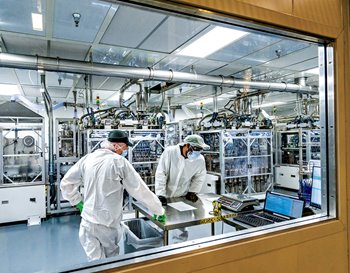Sodium-Ion Batteries Are Powering Up
Sodium-Ion Batteries Are Powering Up


As the global demand for batteries grows in the race to decarbonize, research is evaluating potential complements to the industry favorite, lithium-ion.
Especially in applications involving electric vehicles, lithium-ion batteries might be the darlings of the renewable energy industry, but their popularity has been fraying at the edges. China’s chokehold on lithium—the country is expected to control a third of the world’s output by 2025—is leading the West to pursue alternatives that would ease supply-chain constraints.
A potential candidate is to be had right down the periodic table from lithium: sodium. The industry is excited about the possibility of swapping sodium for lithium and manufacturers are beginning to test the field. Natron Energy Inc., for example, will execute its vision for sodium-ion batteries in a Michigan-based factory owned by Clarios, a battery manufacturer.
The premise of sodium-ion is that switching one element for the other and retaining similar cathode-anode and electrolyte combinations as lithium-ion will lead to similar battery performance characteristics. And sodium-ion batteries will be easy to scale as manufacturing processes can copy the ones already established for lithium-ion.
The costs for sodium are significantly lower too and it’s abundantly available in the earth’s crust, points out Jiguang (Jason) Zhang, recognized expert of energy storage devices and laboratory fellow at the energy processes & materials division at the Pacific Northwest National Laboratory (PNNL). In addition, sodium-ion batteries lend themselves to recycling and are environmentally friendly, Zhang said.
While sodium-ion batteries offer a host of advantages, they also present challenges.
Substituting sodium for lithium might lead to compatible chemistries but because sodium is three times heavier and has a lower redox potential, it packs less energy. “LFP (lithium iron phosphate) cells get about 160 W/kg, the current generation of sodium does about 140,” said Dylan Khoo, industry analyst at ABI Research, a technology intelligence firm.
Become a Member: How to Join ASME
The energy density for sodium-ion is about 30 percent less than the lithium equivalent. Such lower energy density is a problem because it means you have to use more batteries to do the equivalent job that a lithium-ion battery might perform. This condition precludes the sodium-ion from use in high-performance EVs because space and weight are constraints.
Current research on advancing viable sodium-ion batteries focuses on improving the capacity of the cell by increasing operational voltage and on increasing cycle life, which is the number of times the unit can be discharged and recharged before it loses potency.
Most state-of-the-art sodium-ion batteries that use conventional electrolytes need a very stable interfacial layer on the anode and cathode to maintain electrolyte stability. If sodium-ion batteries must compete with lithium-ion, they need to reach higher operational voltages, Zhang explained. Unfortunately, at high voltages, the battery’s interfacial layers dissolve and the electrolyte becomes unprotected and unstable. “That’s one of the main reasons why the sodium-ion batteries have lower capacity and less cycle stability,” he added.
Zhang and a team of researchers at PNNL have developed a promising solution to overcome this challenge: an electrolyte composition that can stabilize the interfacial layer. “Even at higher voltage, this interfacial layer is very stable and can barely be dissolved and therefore we can operate the whole sodium battery at high voltage and high capacity,” Zhang said. The precise composition of the electrolyte: 1.5 M sodium bis(fluorosulfonyl)imide (NaFSI) salt in a solvent mixture of dimethyl carbonate (DMC) and tris (2,2,2-trifluoroethyl) phosphate (TFP) (1.5:2 in mole or 1.6:8.4 in wt.)
Use in EVs need not be the gold standard for the inclusion of sodium-ion (or any other candidate) as battery alternatives, the experts argue. Khoo suggested that even in cars, sodium-ion batteries could be used in urban areas where shorter trips might be the norm and where cost advantage might be a more important driver.
Sodium-ion batteries can also be used in other applications, including in energy storage for grid operations where weight and energy density might not be deal-breakers. Rapid advances in research and development can also strengthen sodium-ion’s abilities beyond where they are today.
Ramping up advances in sodium-ion might have another appealing reason: The 2022 Inflation Reduction Act, which allocated close to $370 billion in funding for clean energy and climate-related spending, with a few billion earmarked specifically for the manufacturing of EVs and batteries. The legislation also mandates manufacturing and sourcing of raw materials within the United States, which favors sodium-ion.
“[Sodium-ion] has been relatively neglected in the mass consciousness,” Khoo said. But that’s changing. “Big battery manufacturers are now going to have quite good sodium-ion roadmaps and offerings coming out in the near future,” he predicted.
Indeed, this year Chinese company CATL announced plans to manufacture sodium-ion batteries, packaging them with their lithium-ion counterparts in one unit. And recently news broke that a former executive at battery manufacturer, Enovix, launched a startup devoted to developing low-cost sodium-ion batteries.
Poornima Apte is a science and technology writer in Boston, Mass.

A potential candidate is to be had right down the periodic table from lithium: sodium. The industry is excited about the possibility of swapping sodium for lithium and manufacturers are beginning to test the field. Natron Energy Inc., for example, will execute its vision for sodium-ion batteries in a Michigan-based factory owned by Clarios, a battery manufacturer.
The sodium-ion promise
The premise of sodium-ion is that switching one element for the other and retaining similar cathode-anode and electrolyte combinations as lithium-ion will lead to similar battery performance characteristics. And sodium-ion batteries will be easy to scale as manufacturing processes can copy the ones already established for lithium-ion.
The costs for sodium are significantly lower too and it’s abundantly available in the earth’s crust, points out Jiguang (Jason) Zhang, recognized expert of energy storage devices and laboratory fellow at the energy processes & materials division at the Pacific Northwest National Laboratory (PNNL). In addition, sodium-ion batteries lend themselves to recycling and are environmentally friendly, Zhang said.
Challenges and research
While sodium-ion batteries offer a host of advantages, they also present challenges.
Substituting sodium for lithium might lead to compatible chemistries but because sodium is three times heavier and has a lower redox potential, it packs less energy. “LFP (lithium iron phosphate) cells get about 160 W/kg, the current generation of sodium does about 140,” said Dylan Khoo, industry analyst at ABI Research, a technology intelligence firm.
Become a Member: How to Join ASME
The energy density for sodium-ion is about 30 percent less than the lithium equivalent. Such lower energy density is a problem because it means you have to use more batteries to do the equivalent job that a lithium-ion battery might perform. This condition precludes the sodium-ion from use in high-performance EVs because space and weight are constraints.
Current research on advancing viable sodium-ion batteries focuses on improving the capacity of the cell by increasing operational voltage and on increasing cycle life, which is the number of times the unit can be discharged and recharged before it loses potency.
Team focus
Most state-of-the-art sodium-ion batteries that use conventional electrolytes need a very stable interfacial layer on the anode and cathode to maintain electrolyte stability. If sodium-ion batteries must compete with lithium-ion, they need to reach higher operational voltages, Zhang explained. Unfortunately, at high voltages, the battery’s interfacial layers dissolve and the electrolyte becomes unprotected and unstable. “That’s one of the main reasons why the sodium-ion batteries have lower capacity and less cycle stability,” he added.
Zhang and a team of researchers at PNNL have developed a promising solution to overcome this challenge: an electrolyte composition that can stabilize the interfacial layer. “Even at higher voltage, this interfacial layer is very stable and can barely be dissolved and therefore we can operate the whole sodium battery at high voltage and high capacity,” Zhang said. The precise composition of the electrolyte: 1.5 M sodium bis(fluorosulfonyl)imide (NaFSI) salt in a solvent mixture of dimethyl carbonate (DMC) and tris (2,2,2-trifluoroethyl) phosphate (TFP) (1.5:2 in mole or 1.6:8.4 in wt.)
More for You: Taming Sodium Hydroxide for Energy Storage
Zhang hopes to steer away from a cathode that uses difficult-to-source cobalt in future research. Future work will also focus on improving the electrolyte structure and composition to further enhance long-term cycle performance. The present status goes to 300 cycles but “we would like to increase that to more than 800 or even 1,000 cycles,” he added.Fueling momentum
Use in EVs need not be the gold standard for the inclusion of sodium-ion (or any other candidate) as battery alternatives, the experts argue. Khoo suggested that even in cars, sodium-ion batteries could be used in urban areas where shorter trips might be the norm and where cost advantage might be a more important driver.
Sodium-ion batteries can also be used in other applications, including in energy storage for grid operations where weight and energy density might not be deal-breakers. Rapid advances in research and development can also strengthen sodium-ion’s abilities beyond where they are today.
Ramping up advances in sodium-ion might have another appealing reason: The 2022 Inflation Reduction Act, which allocated close to $370 billion in funding for clean energy and climate-related spending, with a few billion earmarked specifically for the manufacturing of EVs and batteries. The legislation also mandates manufacturing and sourcing of raw materials within the United States, which favors sodium-ion.
“[Sodium-ion] has been relatively neglected in the mass consciousness,” Khoo said. But that’s changing. “Big battery manufacturers are now going to have quite good sodium-ion roadmaps and offerings coming out in the near future,” he predicted.
Indeed, this year Chinese company CATL announced plans to manufacture sodium-ion batteries, packaging them with their lithium-ion counterparts in one unit. And recently news broke that a former executive at battery manufacturer, Enovix, launched a startup devoted to developing low-cost sodium-ion batteries.
Poornima Apte is a science and technology writer in Boston, Mass.

Climate Change
Learn how ASME leverages its leadership in innovation and technology, workforce development, and policy to catalyze urgent climate outcomes.





